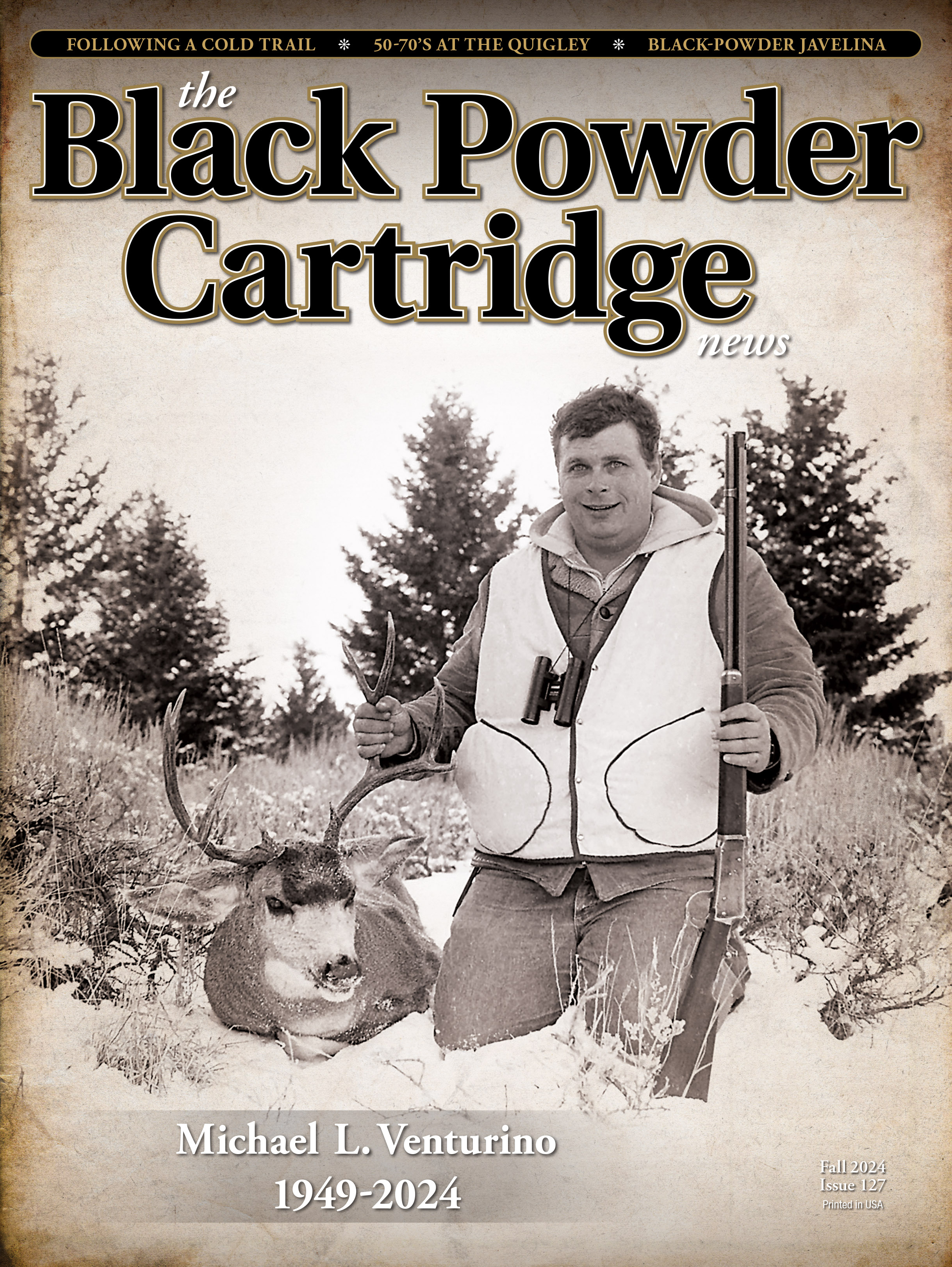
Close up of javelina taken with original 1892 Winchester in 44-40, made in 1897, as a saddle-ring carbine and re-barreled by Winchester in the 1920s. Note the white band, or collar, on the javelina to the right of the rifle. Hence the official name “collared peccary.”
In some of my previous articles, I have mentioned hunting javelina in Arizona, and it was brought to my attention that most Americans are not familiar with them. According to the Internet, they are medium-sized mammals that look similar to wild boars; however, they are more accurately classified as a “collared peccary.” The collar is a white band of hair that goes around the neck/shoulder, and their range is from Arizona to Texas, while other variations live in Central and South America. Peccaries bear a family resemblance to true pigs, due to their prehistoric ancestry, and they are in the same suborder as swine (Suina).

Bleached skull of javelina showing tusks, which are self-sharpening on the upper and lower jaws as the animal chews. These make for deep, ugly wounds, which can kill.
Adult javelina will weigh between 40 and 80 pounds on the hoof, and they usually roam in packs of 10 or less. They are officially classified as herbivores, but they also occasionally eat meat. In fact, I recently found a dead coyote in my yard that was killed and eaten by javelina, and since coyotes are one of their main enemies, they will readily attack domestic dogs. Years ago, one of my prize bird dogs was attacked, and within about five seconds over 800 stitches were required to repair the damage, which ruined the dog for life. Humans are also targeted, especially when walking a dog. A 64-year-old lady was recently hospitalized in Tucson with multiple wounds after being attacked by five javelina. I have personally been attacked and chased several times, fortunately without injury. Their tusks are very formidable weapons, and by clacking them together very fast when threatened, they make a chattering noise designed to warn potential predators to stay away.

This is a size comparison for those who have never seen a javelina. On the left is a good-size male javelina, and on the right is a six-foot, large-size human. Pun intended.
I normally hunt with either muzzleloaders or single-shot breechloaders, but for this hunt I decided to go with an original Winchester Model 1892 with a 20-inch barrel in 44-40 caliber. I wanted just a bit more firepower than normal because I was hunting in the main smuggling corridor in southern Arizona just north of the Mexican border. This is the rugged terrain where most of the illegal migrants come through, not to mention the cartel drug runners.



They can be more dangerous than the bears, cougars or rattlesnakes. My friend, “Wolfdog” Andre, was using an original Model 1873 Winchester with a 24-inch barrel, also in 44-40. As it turned out, both of us got our javelina on the same day. Our traditional 200-grain lead-bullet loads at about 1,100-1,200 feet per second proved more than enough for the task. Other friends in the field were using a cap-and-ball revolver and a muzzleloading .58 caliber smooth rifle, both perfect for up-close action. In Arizona, any cartridge from 22 Magnum on up is legal for the taking of javelina.

The javelina was taken with an original 1873 Winchester rifle in 44-40 by “Wolfdog” Andre. Note that the javelina is missing the lower portion of the left, rear leg. It was shot off due to poor shooting during a previous hunting season, and was completely healed and functional.
Another friend, Ty Hart, had a very close encounter with a lone javelina that he shot at nine feet with a smoothbore single-shot percussion pocket pistol. These are called “turn off” pistols, often having a folding trigger, and this one even had sights. The load was 15 grains of Swiss 2Fg and a .36 caliber round ball, and he shot the pig right in the ear, dropping it instantly on the spot. This doesn’t sound like enough kinetic energy at first thought, but remember that the Colt 1851 Navy revolver in .36 caliber used 18 grains of powder, and some of the velocity was lost through the escape of gas in the gap between the cylinder and the barrel. Ty, as an expert hunter, had been practicing with the pistol and knew that his maximum range was five yards for an accurate killing shot. Why use such a diminutive pistol you say? Well, he has killed javelina with just about every other kind of projectile known to man, so why not?

Here’s something you will probably never see again. A javelina taken with a single shot to the ear from the small smoothbore pistol shown. It dropped like a sack of potatoes. The professional hunter, Ty Hart, had practiced with the gun and knew he had to get very, very close. The javelina was ambushed on a game trail, and Ty is the only guy I know who could pull this off.
Javelina are a real challenge to hunt, as their population density seems to be lower than deer in most places. Their sense of smell is great, but fortunately for the hunter, they have myopic vision, meaning they have poor eyesight at a distance. Can you eat them, you ask? Sure, providing you use lots of barbeque sauce, and there are many jokes about their flavor. Actually, I had some pan-fried tenderloin with just a hint of garlic and butter after the hunt, and it was delicious. When hunting javelina, just remember – for maximum amount of fun – get close and use one of your coveted primitive weapons from your collection. After all, you need something nice to look at and fondle while sitting on that cold rock for hours waiting on your four-legged adversary. Besides, modern scoped rifles are boring and simply too easy for hunting. Why not have a real challenge?










